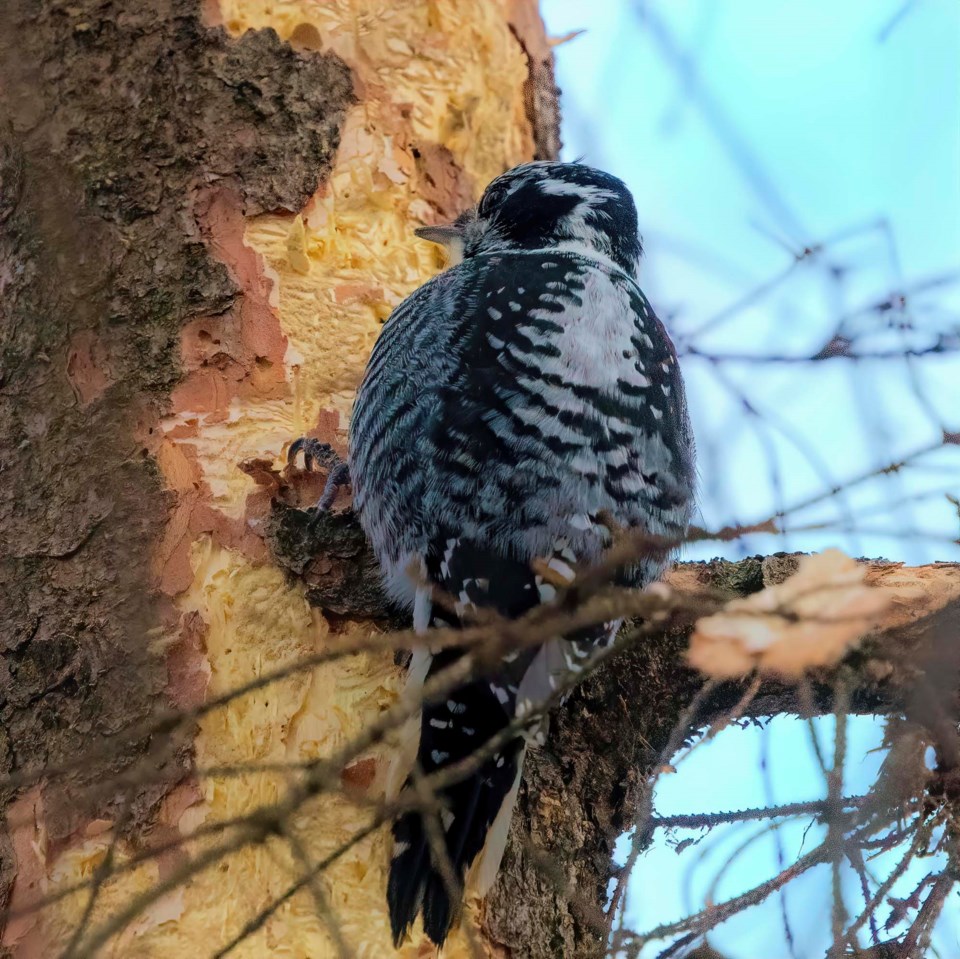Birds counted
A three-toed bark-chipping American was the star attraction of this year’s St. Albert Christmas bird count.
About 65 people ventured forth last Dec. 28 for the 2019 St. Albert Christmas Bird Count. It was the smallest turnout in the count’s history – the count usually draws about 125.
Interim count co-ordinator Elene Haave Audet said the small turnout was likely due in part to the short notice birders had for the count. The count was cancelled in late November when long-time organizer Alan Hingston stepped down, but restored on Dec. 18 when she stepped in as a replacement. Many local birders had already made other plans at that point, and some probably didn’t get the news.
Fewer counters also meant fewer birds counted, with a record low of 2,587 birds enumerated this time round, count results showed. Some 30 species were identified, which was the third lowest in count history.
“It was a quiet bird year,” Haave Audet said, which may be due to the mild winter reducing the need for birds to forage for food.
While there were no new species spotted in the count, birdwatchers did spot one that has been absent from the count since 2004: the American three-toed woodpecker.
The three-toed and black-backed woodpeckers are the only woodpeckers in North America with three toes instead of four, reports the Cornell Lab of Ornithology. Researchers suspect these three-toed feet may let these birds lean back farther and hit harder as they chip away bark from dead or dying trees to get at bark beetles.
While the three-toed and black-backed woodpeckers are both black-and-white robin-sized birds with barred sides and (in male) yellow crowns, the black-backed woodpecker has an all-black back while the three-toed has one that’s white with black bars, the Cornell Lab reports. Hairy and downy woodpeckers have white, unbarred patches on their back and no bars on their flanks.
Absent from the count for the first time since 1998 were American robins. Haave Audet said robins typically migrate in the winter, so it’s to be expected that there wouldn’t be any here this year. (St. Albert typically sees zero to 44 robins during the count.)
Haave Audet said she would forward this year’s results to Birds Canada. She wasn’t sure who would lead the 2020 count.
“Given how important this is to the birding community in St. Albert, I’m quite confident there will be someone more permanent than I in this position in the future.”
Questions on the count should go to Birds Canada national Christmas bird count co-ordinator Yousif Attia at [email protected] or 1-778-689-2473. Visit tabsoft.co/2rE75h4 to explore the count’s results.
Trees for animals
Still got your Christmas tree up? If you don’t want to leave it at the curb, a local wildlife hospital is happy to take it off your hands.
St. Albert’s annual curbside Christmas tree pick-up started this week. Zone B homeowners (most of Lacombe Park, Riverside, Mission, Grandin, Heritage Lakes, Sturgeon Heights, Forest Lawn, Akinsdale and Pineview) can put out their natural Christmas trees for collection from Jan. 6 to 10, while Zone A homeowners (the rest of town) can do so from Jan. 13 to 17.
Trees should be placed on the curb clear of carts and bags and at least a meter from any obstacles on brown cart collection day, the city’s website reports. Trees should not be placed on or in snow banks and should not have decorations or wrap on them. You can also haul your tree to the compost depot on Villeneuve Road.
Collected trees are chipped and composted.
The WILDNorth animal rescue society could also use your old live trees, said rescue manager Dale Gienow.
“We’re overwintering quite a large number of animals right now,” he said, and natural Christmas trees can serve as perches for birds, cover for foxes and food for porcupines.
Gienow said WILDNorth hoped to collect about 30 Christmas trees by the end of January. Trees should be free of wrap or decorations (both of which could harm animals) and be placed on the pile of trees at society’s rehabilitation centre in Parkland County between 9 a.m. and 5 p.m. Visit wildnorth.ca/contact or call 780-914-4118 for directions.
Email [email protected] for questions on curbside tree collection.




